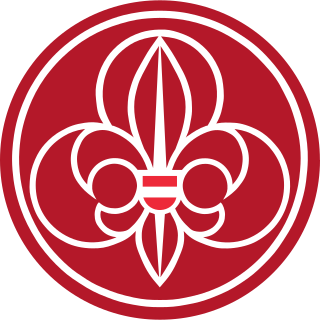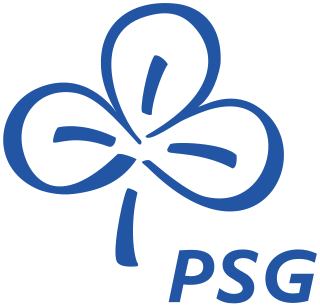
Pfadfinder und Pfadfinderinnen Österreichs is the largest Scouting and Guiding organization in Austria and the only one approved by World Association of Girl Guides and Girl Scouts (WAGGGS) and the World Organization of the Scout Movement (WOSM). The association claims more than 300 troops with more than 85,000 Scouts nationwide. WOSM and WAGGGS give quite smaller membership values for the PPÖ: 27,274 members in WOSM and 10,508 members in WAGGGS.

The Ring deutscher Pfadfinderverbände was the German national Scouting organization within the World Organization of the Scout Movement (WOSM). It served 115,944 members.

The Ring Deutscher Pfadfinderinnenverbände was the German national Guiding organization within the World Association of Girl Guides and Girl Scouts (WAGGGS). It served 47,688 members.

The Verband Christlicher Pfadfinder*innen is a German Protestant coed Scouting and Guiding association. According to the VCP, the organization has about 22,000 members.
The World Federation of Independent Scouts (WFIS) is a non-governmental international Scouting organization with over 7 million members in 151 affiliated Scout organizations in 65 countries. WFIS was formed in Laubach, Germany, in 1996 by Lawrie Dring, a British Scouter with the independent Baden-Powell Scouts' Association (BPSA).

The Scout movement in Germany consists of about 150 different associations and federations with about 260,000 Scouts and Guides.

The Confederation of European Scouts, called in French Confédération Européenne de Scoutisme and abbreviated as CES, was formed in Brussels, Belgium, on 12 November 1978 and is still based in Belgium. CES stresses the European dimension of the Scouting programme and claims to provide the "authentic Scouting of Baden-Powell". The CES is a confederation of national federations. The CES is a split-off from the Fédération du Scoutisme Européen (FSE) later renamed to the Union Internationale des Guides et Scouts d'Europe; it left after controversies about the importance of religious elements in the single associations' programs and co-education. The exact number of members of the CES is unknown.

The Deutsche Pfadfinderschaft Sankt Georg is the largest of Germany's many Scouting organizations. The Catholic association has about 95,000 members of both genders. Via the Ring deutscher Pfadfinder*innenverbände it is a member of the World Organization of the Scout Movement.

Eberhard Koebel also Eberhard Köbel, called tusk, i.e., "the German" in the language of the Sámi people he traveled among, was a German youth leader, writer, and publisher.

The Südtiroler Pfadfinderschaft, abbreviated as SP, is the Catholic Scouting association of the German minority of the Italian province of South Tyrol. The association is coeducational and has 600 members in seven troops. It is affiliated to the Associazione Guide e Scouts Cattolici Italiani (AGESCI), is strongly connected to Pfadfinder und Pfadfinderinnen Österreichs and Slovenian Catholic Girl Guides and Boy Scouts Association Scouting organizations, and maintains some contact with the Deutsche Pfadfinderschaft Sankt Georg. The association owns two campsites in the province.

The Deutsche Freischar – Bund der Wandervögel und Pfadfinder (DF) is a German youth organization. Originating from the merger of several small Wandervogel and Scouting groups, it was one of the largest and most important associations of the Bündische Jugend of the Weimar Republic besides the Deutscher Pfadfinderbund and Reichsschaft Deutscher Pfadfinder.

The Deutsche Pfadfinderverband is an umbrella federation of sixteen German non-denominational Scouting associations. It was founded in 1970 and serves about 29,000 members.

The Deutscher Pfadfinderbund in Namibia is a small Scouting association open mainly to boys and girls of German descent in Namibia.

The Deutscher Pfadfinderbund (DPB) (literal translation German Scouting Union) was the first German Scouting association, and the forerunner of the Deutscher Pfadfinderbund (1945). It existed from 1911 until 1933, when it was disbanded by the National Socialists.
Erich Mönch taught for 20 years at the State Academy of Fine Arts Stuttgart, was an important figure of Tübingen art scene after the Second World War, and after his retirement, he was an honorary member of the State Academy of Fine Arts Stuttgart. He received the Order of Merit of the Federal Republic of Germany in 1970 at retirement for his contribution to the development of lithography.

The Pfadfinderinnenschaft Sankt Georg (PSG) is a German Roman Catholic Girl Scout regionally coed association with about 10,000 members. The national association is a full member of the Ring deutscher Pfadfinder*innenverbände and the World Association of Girl Guides and Girl Scouts (WAGGGS). Founded in 1931 and restarted in 1947, WAGGGS membership was attained in 1950. It is also a member of the International Catholic Conference of Scouting (ICCS) and of the Bund der Deutschen Katholischen Jugend (BDKJ). There is also a parallel Scouting organization with strong ties to the PSG, the Deutsche Pfadfinderschaft Sankt Georg.
Hartmut Keyler is a German architect who served as a member of the World Scout Committee, as well as a member of the European Scout Committee.
The Ring deutscher Pfadfinder*innenverbände is the German national Scouting and Guiding organization within the World Organization of the Scout Movement (WOSM) and the World Association of Girl Guides and Girl Scouts (WAGGGS).













